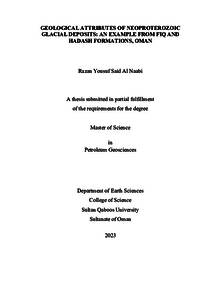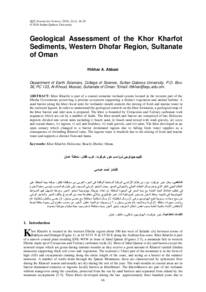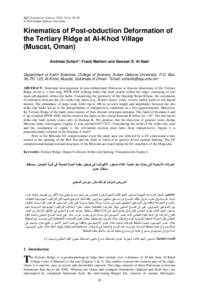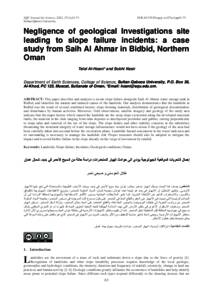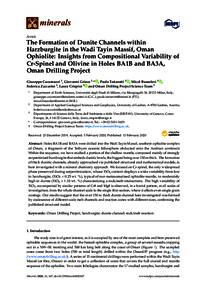وثيقة
Geological attributes of neoproterozoic glacial deposits : an example from Fiq and Hadash formations, Oman.
الناشر
Sultan Qaboos University.
ميلادي
2023
اللغة
الأنجليزية
الملخص الإنجليزي
Glacial deposits are important hydrocarbon reservoirs globally. Thus,
understanding their geological attributes are crucial in hydrocarbon exploration,
appraisal, and production as well as during enhanced oil recovery. The Neoproterozoic
glacial deposits of the Huqf Supergroup are well-exposed across Oman from the north
to the south; Jabal Akhdar and Saih Hatat Window, the Huqf Area, and the Mirbat
Area, respectively. They are represented by the Ghubrah and Fiq formations of the
Abu Mahara Group. Moreover, the Neoproterozoic glacial deposits have been
penetrated by numerous subsurface wells, especially in Central Oman, being an
important hydrocarbon target. Accordingly, this study focuses on examining the
geological attributes of the Abu Mahara and the overlying Hadash Formation that are
poorly documented in literatures. This study aims to gain a better understanding of the
sedimentology and stratigraphy of the two stratigraphic units (i.e., Fiq and Hadash
formations), and their regional facies distribution to eventually correlate their
distribution from north to south, based on surface and subsurface data. Moreover, this
study aims to examine the diagenetic alterations and their impact on reservoir quality
with a sequence stratigraphy.
About 400 m of the outcropped and 33 m of the cored Ghubrah, Fiq and Hadash
formations were used for the sedimentological and stratigraphic examination including
facies analysis, sequence stratigraphic interpretation, boundary relationship and the
nature of the bounding surface between the Fiq and Hadash formations. In total, 34
selected samples were collected (26 samples from outcrop and 8 samples from core
for petrographic and geochemical analyses including thin section microscopic
analysis, point counting, diagenesis, X-ray florescence, scanning electron microscope
analyses for mineralogical and authigenic phases identification. Sedimentological
examination showed the Fiq Formation is represented by proximal to distal
glaciomarine and proglacial facies associations. The proximal glaciomarine
diamictites are clast-rich, unlike the distal glaciomarine diamictites, which have
typical clast-poor nature. Local glacier features (i.e., ice-rafted granitic dropstones)
display clear evidence of active glaciation during deposition of the Fiq Formation. The
distal glaciomarine facies make up most of the logged section suggesting that most the
stratigraphic succession of the Fiq Formation has been deposited during glacial retreat
cycles. Proglacial facies are also further subdivided into gravity-flow, and braided
fluvial deposits. The Fiq Formation represents cycles of sea level rise and fall events
formed during local and multiple glaciation and deglaciation events.
Fiq Formation is overlain by microbial-based planar stromatolites intercalated
with siltstone deposits. These deposits represent an intertidal environment. The abrupt
change in facies from proximal glaciomarine diamicitites to intertidal based
stromatolitic dolostones support the transition in the climatic condition from cold to
hot 'tropical' marking the definite end of the glaciation during Fiq Formation
deposition and earliest development of multicellular organisms within the Hadash
Formation.
Subsurface diamictites of the Ghubrah Formation are characterized by flat-iron
shaped clasts providing further evidence of glaciation. The subsurface Fiq Formation
revealed comparable lithofacies to those observed in outcrop, represented mainly by
the proglacial, gravity flow facies along association. Additional facies association have
been recognized within the subsurface Fiq Formation, which is represented by peloidal
packstones which are intercalated with laminated and crenulated mudstones
suggesting interglacial deposition within deep-water setting with occasional influx of
calciturbidites, implying formation of cool-water carbonates in an interglacial system.
The surface proglacial sandstones of the Fiq Formation are mainly
sublitharenite and subarkose in composition which are characterized by post depositional burial diagenetic cementation and early mechanical and chemical
compaction implying poor reservoir quality. Comparable post depositional diagenetic
alterations were found in the surface and subsurface facies of the Hadash Formation
represented mainly by saddle dolomite and silica that drastically reduces reservoir
quality. Authigenic evaporitic minerals have been recognized within both surface and
subsurface dolomitic samples of the Hadash Formation, supporting the proposed
suggestion of transition from cold to hot climatic condition. The integrated
sedimentological, stratigraphic and diagenetic outcomes of this study can be used as
analogue to test the development of these stratigraphic units as potential hydrocarbon
plays in further studies.
المجموعة
URL المصدر
قالب العنصر
الرسائل والأطروحات الجامعية

